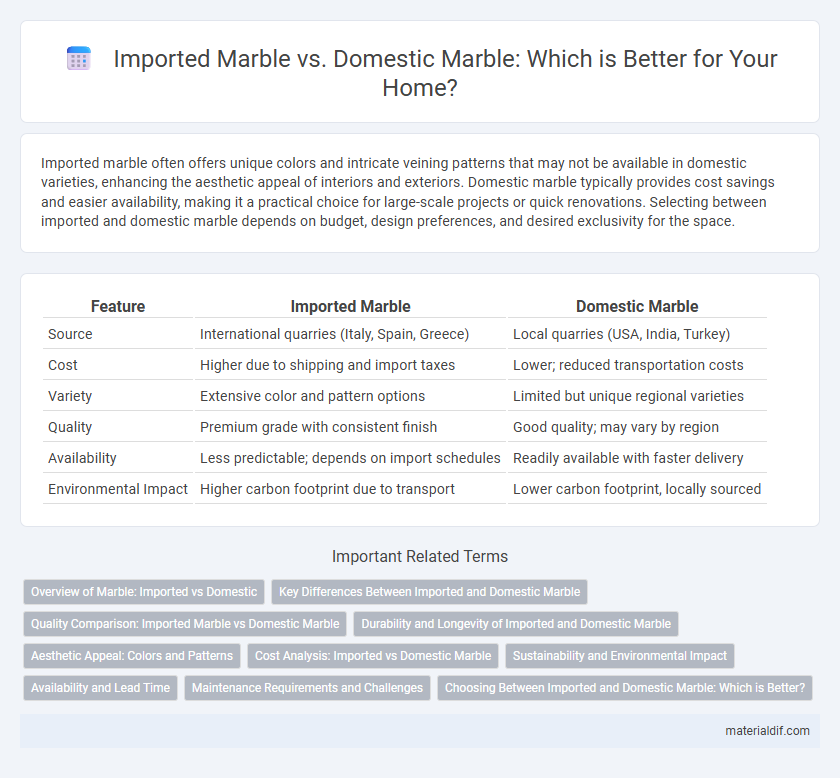Imported marble often offers unique colors and intricate veining patterns that may not be available in domestic varieties, enhancing the aesthetic appeal of interiors and exteriors. Domestic marble typically provides cost savings and easier availability, making it a practical choice for large-scale projects or quick renovations. Selecting between imported and domestic marble depends on budget, design preferences, and desired exclusivity for the space.
Table of Comparison
| Feature | Imported Marble | Domestic Marble |
|---|---|---|
| Source | International quarries (Italy, Spain, Greece) | Local quarries (USA, India, Turkey) |
| Cost | Higher due to shipping and import taxes | Lower; reduced transportation costs |
| Variety | Extensive color and pattern options | Limited but unique regional varieties |
| Quality | Premium grade with consistent finish | Good quality; may vary by region |
| Availability | Less predictable; depends on import schedules | Readily available with faster delivery |
| Environmental Impact | Higher carbon footprint due to transport | Lower carbon footprint, locally sourced |
Overview of Marble: Imported vs Domestic
Imported marble often features unique veining patterns and diverse color palettes sourced from countries like Italy, Spain, and Turkey, offering premium aesthetics for luxury projects. Domestic marble, primarily mined in the United States and Canada, provides cost-effective solutions with easier availability and quicker lead times, making it ideal for budget-conscious and local construction. Both types vary in durability and maintenance requirements, influenced by geological conditions and quarrying techniques specific to their regions.
Key Differences Between Imported and Domestic Marble
Imported marble often features unique veining patterns and rarer colors sourced from countries like Italy, Spain, and Turkey, offering exclusive aesthetics not commonly found in domestic variants. Domestic marble, predominantly quarried in the United States, typically provides cost-efficiency, easier availability, and quicker delivery times, making it a practical choice for large-scale projects. Differences in density and porosity between imported and domestic marble affect their durability and maintenance requirements, with some imported marbles requiring more careful sealing and upkeep.
Quality Comparison: Imported Marble vs Domestic Marble
Imported marble often exhibits superior quality due to advanced quarrying techniques and stricter quality control standards in countries like Italy and Spain. Domestic marble, while typically more affordable and readily available, may show variations in durability and finish depending on regional deposits and processing methods. Quality differences impact applications such as countertops and flooring, with imported marble favored for high-end projects requiring consistent color, density, and polish.
Durability and Longevity of Imported and Domestic Marble
Imported marble often exhibits superior durability due to its unique mineral compositions and denser grain structures found in regions like Italy and Spain. Domestic marble can vary significantly in longevity depending on the specific quarry, with some local varieties offering comparable strength but generally less resistance to wear and environmental factors. Maintenance requirements also differ, as imported marble tends to retain its finish longer under heavy use, enhancing its lifespan in residential and commercial applications.
Aesthetic Appeal: Colors and Patterns
Imported marble offers an extensive palette of unique colors and intricate patterns often unavailable in domestic varieties, elevating luxury interior designs with its exotic appeal. Domestic marble typically features more uniform tones and classic veining patterns, providing a timeless and cohesive aesthetic favored in traditional architecture. Selecting between imported and domestic marble depends on the desired visual impact and the specific color scheme of the project.
Cost Analysis: Imported vs Domestic Marble
Imported marble often incurs higher costs due to international shipping fees, import taxes, and currency exchange rates, making it generally more expensive than domestic marble. Domestic marble benefits from reduced transportation expenses and local supply chain efficiencies, resulting in lower overall costs for builders and homeowners. Price variations also depend on the grade, rarity, and source location, but domestic options typically offer greater affordability without sacrificing quality.
Sustainability and Environmental Impact
Imported marble often involves significant carbon emissions due to long-distance transportation and energy-intensive quarrying processes, raising sustainability concerns. Domestic marble generally has a lower environmental impact by reducing transportation-related emissions and supporting local quarry regulations that may emphasize ecological responsibility. Choosing locally sourced marble can contribute to a smaller carbon footprint and promote sustainable building practices.
Availability and Lead Time
Imported marble often faces longer lead times due to international shipping, customs clearance, and limited availability of specific quarry sources, affecting project deadlines. Domestic marble typically offers faster availability and shorter lead times, benefiting from local quarry access and streamlined distribution channels. Choosing domestic marble can minimize delays and ensures quicker replenishment for large-scale or time-sensitive projects.
Maintenance Requirements and Challenges
Imported marble often requires specialized sealants and more frequent reapplication due to its varied porosity and sensitivity to local environmental conditions, increasing maintenance complexity. Domestic marble generally benefits from easier access to compatible cleaning products and professional services familiar with its specific characteristics, reducing upkeep challenges. Both types demand regular sealing to prevent staining, but imported variants may pose higher risks of discoloration and surface etching if not properly maintained.
Choosing Between Imported and Domestic Marble: Which is Better?
Imported marble offers unique patterns and rarer colors sourced from renowned quarries in Italy, Spain, and Turkey, often commanding higher prices due to transportation and luxury appeal. Domestic marble, primarily quarried in the United States from states like Vermont, Colorado, and Georgia, provides cost-effective, durable options with reduced shipping time and environmental impact. Choosing between imported and domestic marble depends on budget constraints, desired aesthetic, and project location, where domestic marble maximizes value and sustainability while imported marble elevates exclusivity and design statement.
Imported Marble vs Domestic Marble Infographic

 materialdif.com
materialdif.com